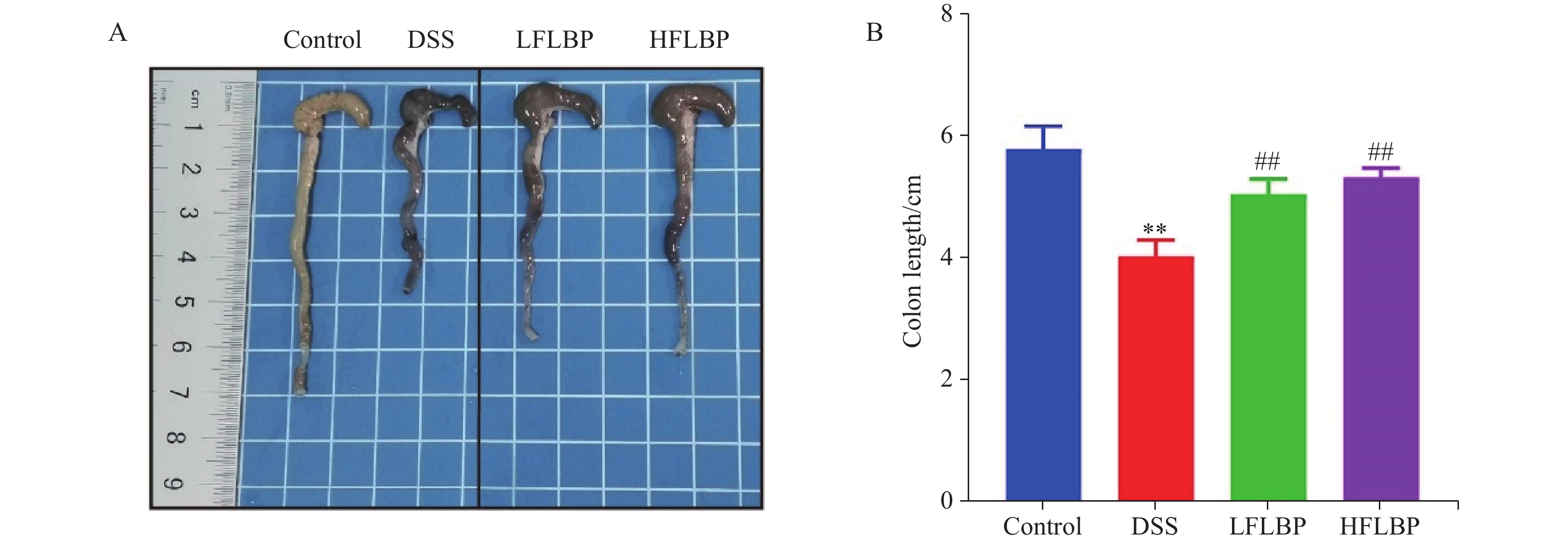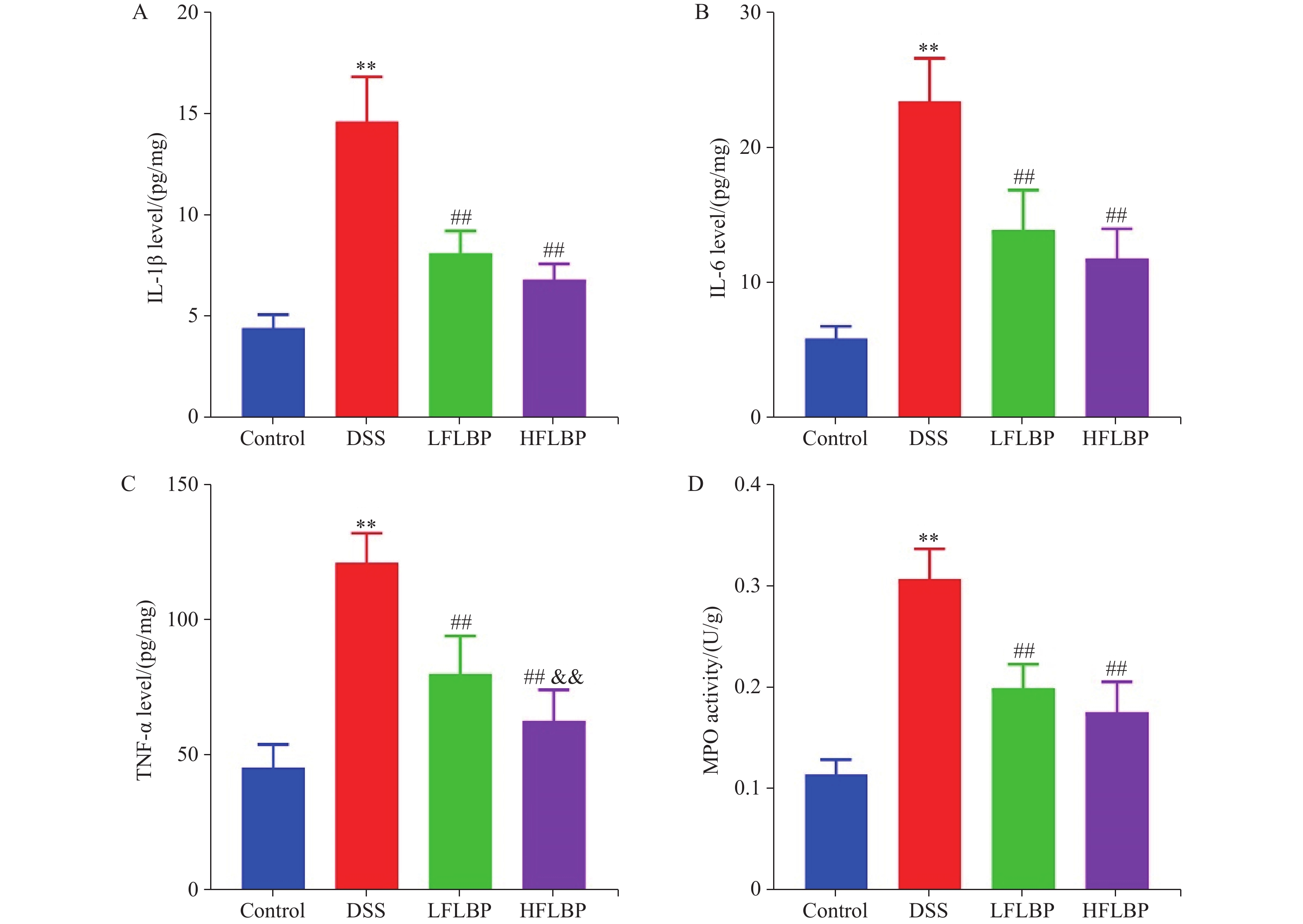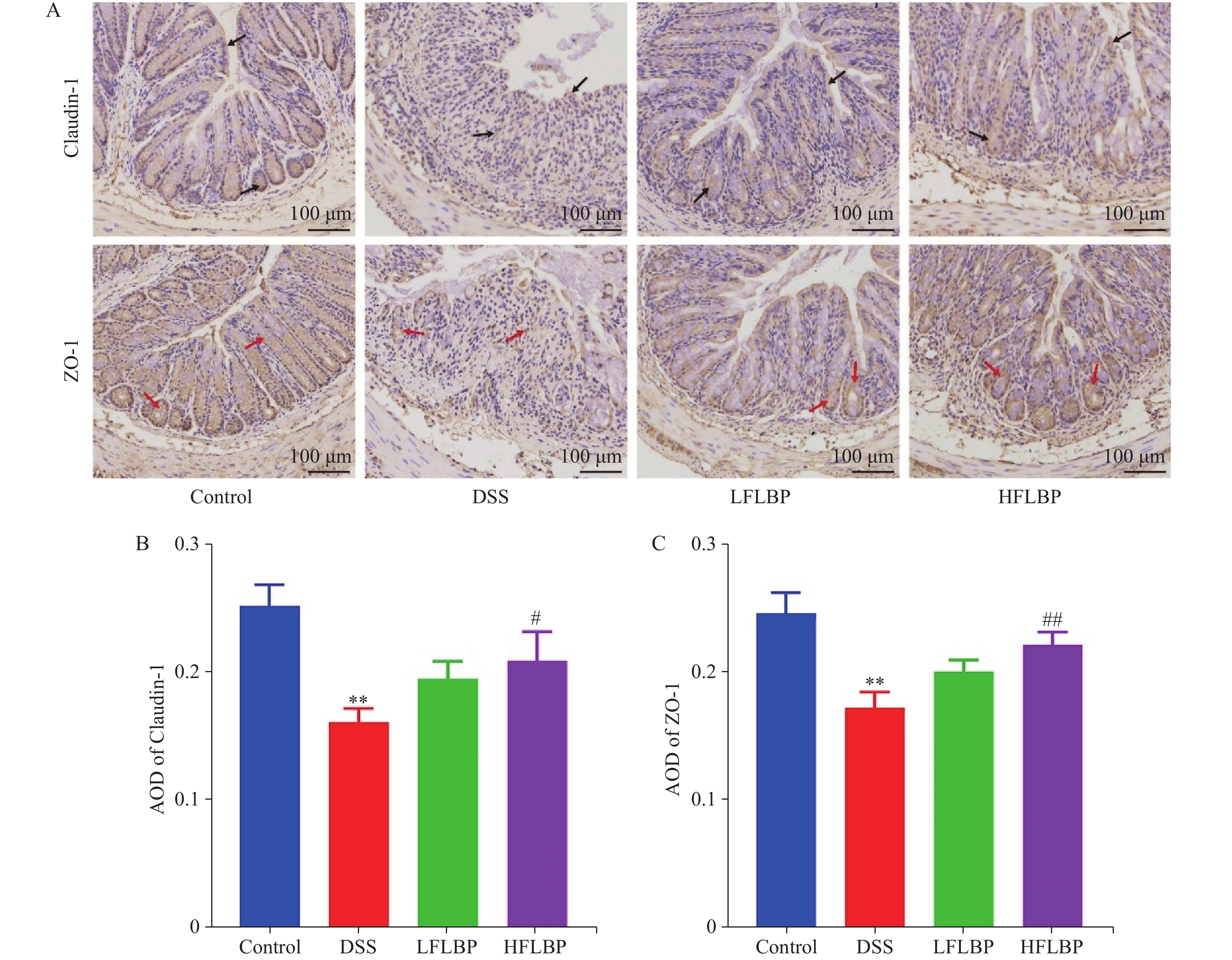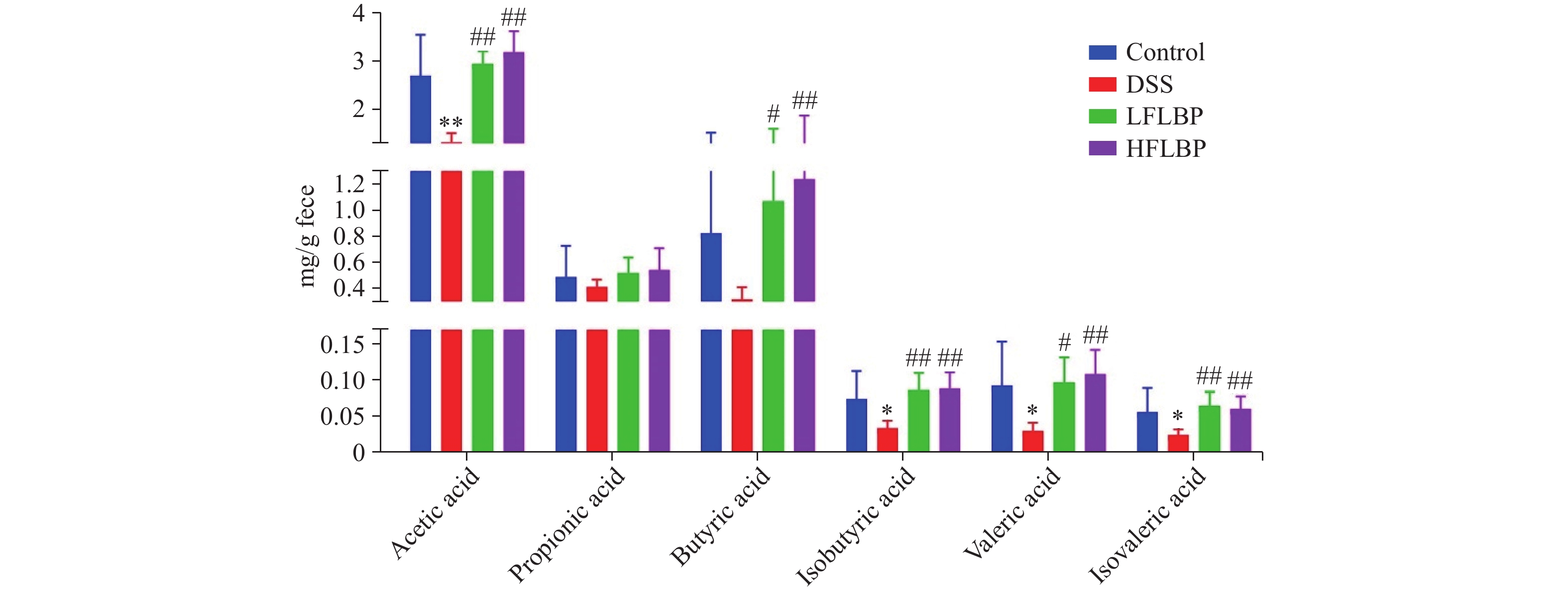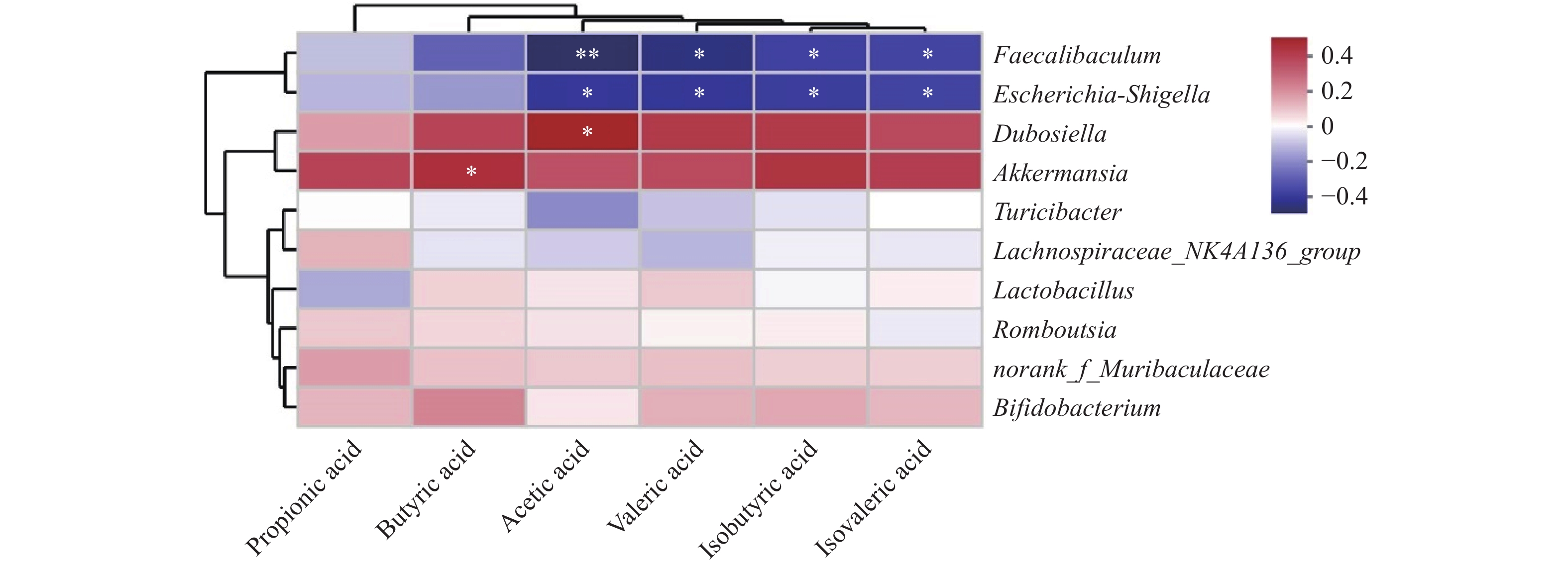Amelioration of dextran sulfate sodium-induced ulcerative colitis by fermented Lycium barbarum polysaccharides through modulation of intestinal microecology
-
摘要:
为探究多糖益生元调节肠道微生态作用机制,采用ELISA法、组织病理学分析、免疫组化分析、16S rRNA高通量测序、气相色谱-质谱联用等方法,研究发酵多糖对葡聚糖硫酸钠(DSS)诱导结肠炎模型小鼠肠道菌群和短链脂肪酸(SCFAs)变化的影响及其与肠道炎症水平、屏障蛋白表达的关系。结果发现,发酵枸杞多糖(FLBP)可显著降低小鼠肠道炎症水平,改善结肠组织结构,上调紧密连接蛋白Claudin-1和ZO-1表达量,同时显著增加肠道SCFAs含量。肠道菌群分析结果表明,FLBP可富集小鼠肠道杜氏芽孢杆菌(Dubosiella)和阿克曼氏菌属(Akkermansia),降低Turicibacter菌属、肠杆菌属(Faecalibaculum)、埃希氏菌-志贺菌属(Escherichia-Shigella)丰度。研究结果表明,FLBP激活重塑的杜氏芽孢杆菌在改善结肠炎中占主导作用,显著提升SCFAs含量,增强肠道屏障,降低肠道炎症。研究旨在为改善结肠炎提供更安全有益的选择,并为开发FLBP功能性食品提供理论依据。
-
关键词:
- 发酵枸杞多糖 /
- 结肠炎 /
- 肠道屏障蛋白 /
- 肠道菌 /
- 短链脂肪酸;葡聚糖硫酸钠
Abstract:To explore the mechanism of the intestinal microecology regulation by polysaccharide prebiotics, ELISA, histopathologic analysis, immunohistochemical analysis, 16S rRNA high-throughput sequencing, and gas chromatography-mass spectrometry were applied to investigate the effects of fermented polysaccharides on changes in the intestinal microbiota and short-chain fatty acids (SCFAs) in mice with dextran sulfate sodium (DSS)-induced colitis model and their relationship with the level of intestinal inflammation and barrier protein expression. It was found that fermented Lycium barbarum polysaccharides (FLBP) significantly reduced intestinal inflammation level, improved colonic tissue structure, up-regulated the expression of tight junction proteins Claudin-1 and ZO-1, and significantly increased the content of intestinal SCFAs in mice. Gut bacteria analyses showed that FLBP enriched intestinal Dubosiella and Akkermansia in mice and decreased the abundance of Turicibacter, Faecalibaculum, and Escherichia-Shigella. Results showed that remodeled Dubosiella activated by FLBP played a dominant role in ameliorating colitis by significantly increasing SCFAs content, improving intestinal barrier and reducing intestinal inflammation. The study aimed to provide a safer and better option for the amelioration of colitis and to provide a theoretical basis for the development of functional foods with FLBP.
-
溃疡性结肠炎发病于结肠和直肠部位,具有腹泻、便血等特点,其发病率日渐上升,该病长期反复发作可增加结直肠癌发生的风险。目前结肠炎的发病机制主要与肠道上皮屏障修复、肠道菌群失调和代谢等有关[1]。治疗药物主要包括5-氨基水杨酸、生物制剂和免疫调节剂等[2]。药物的长期使用具有高血压、骨髓抑制等副作用,寻求更安全的缓解结肠炎的替代品受到研究者们广泛的关注[3]。
枸杞(Lycium barbarum),茄科枸杞属植物,在我国宁夏等地方广泛分布,是传统滋补中药和药食同源食物,具有补肾保肝、益精明目等作用[4]。研究表明,枸杞富含多糖、类胡萝卜素、类黄酮等多种生物活性成分[5],具有保护视网膜、保肝、抗炎等多种现代药理作用[6]。微生物发酵利用微生物产生的酶水解植物细胞壁,释放有效成分,同时将有效成分中大分子物质降解为小分子化合物[7],更容易被人体吸收。目前有关发酵枸杞多糖(FLBP)改善结肠炎的研究较少。本研究通过建立小鼠溃疡性结肠炎模型,研究FLBP对小鼠结肠炎症的改善作用,并探究相关作用机制,以期为改善结肠炎提供更加安全有益的选择,并为FLBP功能性食品的进一步开发和应用提供理论依据。
1. 材 料
1.1 药品与试剂
葡聚糖硫酸钠(DSS,Mr 36 kD~50 kD,美国MP Biomedicals公司);IL-1β、IL-6、TNF-α ELISA试剂盒(江苏酶免实业有限公司);髓过氧化物酶(MPO)试剂盒(南京建成生物工程研究所);Claudin-1兔抗(武汉三鹰生物技术有限公司);ZO-1兔抗(武汉爱博泰克生物科技有限公司);其他化学试剂均为市售分析纯。
1.2 仪 器
Speedmill-plus组织研磨仪(德国耶拿分析仪器有限公司);Micro 17R小型台式冷冻离心机(美国Thermo Fisher Scientific公司);Spectra ID5酶标仪(美国Molecular Devices公司);RM2255轮转式切片机、DMi 1倒置显微镜(德国Leica公司)。
1.3 动 物
雄性C57BL/6小鼠,体重18~22 g,6~8周龄,购于成都达硕实验动物有限公司,实验动物生产许可证号:SCXK(川)2020-030。
2. 方 法
2.1 药物制备
取枸杞子100 g,加入10倍质量的80 ℃无菌水,匀浆,在121℃灭菌20 min,按100︰1接种枯草芽孢杆菌(1×1010 cfu/g),30 ℃下摇床培养72 h,10000 r/min离心10 min收集上清液,Savege法去除蛋白质后,加入2倍体积的无水乙醇,4 ℃静置过夜,收集沉淀,喷雾干燥后得FLBP,得率为10.58%。经苯酚-硫酸法测得多糖质量分数为91.50%。
2.2 小鼠肠炎模型的制备及给药方法
选用32只雄性C57BL/6小鼠,适应性饲养1周后,随机分成4组,分别为对照组(Control)、模型组(DSS)、低剂量发酵枸杞多糖组(LFLBP)、高剂量发酵枸杞多糖组(HFLBP),每组8只。各组小鼠连续灌胃30 d,对照组和DSS组灌胃蒸馏水,LFLBP组灌胃150 mg/kg剂量的FLBP溶液,HFLBP组灌胃300 mg/kg剂量的FLBP溶液。在第22~30 天期间,除对照组外,其余各组小鼠均给予2.5%的DSS溶液并让其连续自由饮用9 d诱导结肠炎[8]。第31天收集各组小鼠粪便后解剖,测量结肠长度,取远端结肠浸入4%多聚甲醛溶液进行组织固定,收集结肠内容物和组织样本供后续相关指标测定,试验周期共30 d。
2.3 体重和疾病活动指数(DAI)监测
在试验周期前21 天,每7 天对各组小鼠称重并记录1次。在最后9 d,每天称重小鼠并记录,同时观察并记录其直肠出血和粪便黏稠度情况,统计DAI值[DAI=(体重下降评分+直肠出血评分+粪便性状评分)/3]。DAI评判标准参照文献[9],具体如下:小鼠体重无下降,粪便中无血迹且粪便黏稠度正常,分值为0;体重下降0.1%~5%,粪便中少量带血且粪便松软,分值为1;体重下降5%~10%,粪便中带血且出现轻度腹泻,分值为2;体重下降超过10%,所有粪便中带血且出现腹泻,分值为3。
2.4 结肠组织炎症因子测定
准确称取小鼠结肠组织,按质量体积比1︰9加入预冷的PBS溶液,匀浆,组织匀浆液经过20 min离心(4 ℃、3000 r/min)后,收集上清液,BCA法测总蛋白浓度,炎症因子IL-1β、IL-6、TNF-α的值用ELISA法测定。
2.5 结肠组织髓过氧化物酶(MPO)测定
准确称取小鼠结肠组织,按质量体积比1︰19加入预冷的PBS溶液,匀浆,所得匀浆液按试剂盒检测方法测定MPO。
2.6 结肠组织病理学观察
用4%多聚甲醛溶液对远端结肠样本进行过夜固定后,用不同浓度乙醇溶液脱水,二甲苯透明后包埋在石蜡中,切成5 μm厚的切片,经苏木精-伊红染色后用倒置显微镜观察。
2.7 结肠组织肠道屏障蛋白的表达
切片脱蜡和复水后,在柠檬酸钠缓冲液(pH 6.0)中修复抗原,内源性过氧化物酶由3%过氧化氢溶液避光阻断。用5%山羊血清封闭30 min阻断非特异性结合点,用Claudin-1和ZO-1抗体在4 ℃下孵育过夜,二抗孵育50 min,用DAB显色液显色后再用苏木精复染。经过不同浓度乙醇脱水,二甲苯透明,最后用中性树胶封片,用倒置显微镜观察。
2.8 肠道菌群高通量测序
将小鼠结肠内容物送至上海美吉生物医药科技有限公司进行16S rRNA测序。肠道细菌基因组总DNA采用DNA提取试剂盒抽提。DNA提取数量和质量用琼脂糖凝胶电泳进行评估。使用16S rRNA基因V3-V4高变异区的特异性引物进行PCR扩增DNA序列,然后在Illumina Miseq PE300平台上测序。将相似度 ≥ 97%的有效序列用Uparse v 11软件聚类到相同的操作分类单元。使用Silva v138数据库对每个代表序列注释分类信息。通过物种注释的结果进行alpha多样性、beta多样性以及物种组成分析。
2.9 粪便短链脂肪酸(SCFAs)含量测定
将小鼠粪便送至武汉迈特维尔生物科技有限公司进行SCFAs含量测定。准确称重粪便样品20 mg,加入磷酸溶液(0.5%)1 mL研磨均匀,离心10 min(4 ℃、12000 r/min)。取上清液100 μL,加入含内标的甲基叔丁基醚溶剂500 μL,涡旋3 min,再次离心10 min(4 ℃、12000 r/min)。取上层清液200 μL至进样瓶,用DB-FFAP(30 m × 0.25 mm × 0.25 μm)毛细管柱气相色谱-质谱联用仪分析测定SCFAs含量。
2.10 数据处理与分析
使用GraphPad Prism 9.0软件进行统计学分析,采用单因素方差分析(One-Way ANOVA),用Tukey进行多重比较检验。采用Kruskal-Wallis秩和检验对肠道菌群相对丰度进行统计学分析。数据以$ \bar{x}\pm s $表示,P < 0.05表示具有统计学显著差异。
3. 结 果
3.1 FLBP对小鼠体重和DAI的影响
由图1-A看出,在试验周期前21 天,各组小鼠体重稳定上升。在后9 天的DSS造模期间,对照组小鼠体重稳定上升,其余各组小鼠体重在第27天开始下降。DSS组小鼠体重较对照组显著下降(P < 0.01);LFLBP组和HFLBP组较DSS组体重下降显著减缓(P < 0.01)。由图1-B可知,DSS组小鼠较对照组DAI显著升高(P < 0.01);LFLBP组和HFLBP组DAI较DSS组显著下降(P < 0.01)。结果表明,FLBP可缓解结肠炎小鼠体重下降和DAI升高,高剂量FLBP的作用较低剂量更好。
![]() Figure 1. Effect of fermented Lycium barbarum polysaccharides (FLBP) on changes in body weight and disease activity index (DAI) in mice ($ \bar{x}\pm s $, n = 8)A: Body weight; B: DAI score DSS: Dextran sulfate sodium; LFLBP: Low-dose FLBP; HFLBP: High-dose FLBP**P < 0.01 vs control group; ##P < 0.01 vs DSS group
Figure 1. Effect of fermented Lycium barbarum polysaccharides (FLBP) on changes in body weight and disease activity index (DAI) in mice ($ \bar{x}\pm s $, n = 8)A: Body weight; B: DAI score DSS: Dextran sulfate sodium; LFLBP: Low-dose FLBP; HFLBP: High-dose FLBP**P < 0.01 vs control group; ##P < 0.01 vs DSS group3.2 FLBP对小鼠结肠长度的影响
由图2-A可以看出,LFLBP组和HFLBP组小鼠结肠长度较DSS组长而较对照组短。由图2-B可知,DSS组中小鼠结肠长度较对照组显著缩短(P < 0.01),FLBP干预后的小鼠结肠长度显著增加(P < 0.01),表明FLBP可改善结肠炎小鼠结肠长度缩短的情况。
3.3 FLBP对小鼠结肠组织炎症因子和MPO表达的影响
由图3-A~3-C可知,DSS组小鼠结肠组织中IL-1β、IL-6、TNF-α的表达较对照组显著升高(P < 0.01),FLBP可显著降低这些炎症因子的表达(P < 0.01)。MPO活力升高可反映组织损伤程度,由图3-D看出,DSS组小鼠结肠组织中MPO活力较对照组显著升高(P < 0.01),FLBP可显著降低MPO活力(P < 0.01)。结果表明,FLBP可缓解小鼠结肠炎症和组织损伤,高剂量FLBP效果较低剂量好,其中高剂量FLBP对TNF-α的降低作用显著优于低剂量FLBP。
![]() Figure 3. Effect of FLBP on inflammatory cytokines and myeloperoxidase (MPO) expression in mice colonic tissues ($ \bar{x}\pm s $, n = 8)A: Level of IL-1β in colon; B: Level of IL-6 in colon; C:Level of TNF-α in colon; D: Activity of MPO in colon**P < 0.01 vs control group; ##P < 0.01 vs DSS group; &&P < 0.01 vs LFLBP
Figure 3. Effect of FLBP on inflammatory cytokines and myeloperoxidase (MPO) expression in mice colonic tissues ($ \bar{x}\pm s $, n = 8)A: Level of IL-1β in colon; B: Level of IL-6 in colon; C:Level of TNF-α in colon; D: Activity of MPO in colon**P < 0.01 vs control group; ##P < 0.01 vs DSS group; &&P < 0.01 vs LFLBP3.4 FLBP对结肠肠道屏障的影响
3.4.1 FLBP对小鼠结肠组织HE染色的影响
由图4看出,对照组小鼠肠道上皮结构排列整齐,隐窝结构完整,杯状细胞正常分布,无炎症性细胞浸润。DSS组小鼠较对照组肠道上皮结构和隐窝结构被破坏,杯状细胞减少,出现炎症性细胞浸润。LFLBP和HFLBP组小鼠较DSS组结肠上皮细胞结构和隐窝结构大部分完整,排列较规则,杯状细胞分布较正常,炎症性细胞浸润较少,表明FLBP可通过维持肠道上皮结构完整缓解结肠炎症。
3.4.2 FLBP对小鼠结肠屏障蛋白表达的影响
由图5-A看出,DSS组小鼠较对照组Claudin-1和ZO-1蛋白表达减少,FLBP可增加小鼠结肠组织中这些蛋白的表达。由图5-B,5-C可知,通过对各组小鼠Claudin-1和ZO-1蛋白表达进行平均光密度(AOD)分析,DSS组小鼠Claudin-1和ZO-1蛋白AOD显著低于对照组(P < 0.01),FLBP干预后小鼠Claudin-1和ZO-1蛋白AOD较DSS组升高,其中HFLBP组小鼠Claudin-1和ZO-1蛋白AOD显著升高(P < 0.05、P < 0.01)。结果表明FLBP可通过上调肠道紧密连接蛋白的表达,增强肠道屏障功能,缓解结肠炎症。
![]() Figure 5. Effect of FLBP on colonic barrier protein expression in mice ($ \bar{x}\pm s $, n = 3)A: Expression of Claudin-1 protein and ZO-1 protein; B: Average optical density (AOD) of Claudin-1; C: AOD of ZO-1 Note: Black arrows are Claudin-1 protein expression and red arrows are ZO-1 protein expression**P < 0.01 vs control group; #P < 0.05, ##P < 0.01 vs DSS group
Figure 5. Effect of FLBP on colonic barrier protein expression in mice ($ \bar{x}\pm s $, n = 3)A: Expression of Claudin-1 protein and ZO-1 protein; B: Average optical density (AOD) of Claudin-1; C: AOD of ZO-1 Note: Black arrows are Claudin-1 protein expression and red arrows are ZO-1 protein expression**P < 0.01 vs control group; #P < 0.05, ##P < 0.01 vs DSS group3.5 FLBP对小鼠肠道菌群的影响
3.5.1 FLBP对肠道菌群多样性的影响
由图6-A可知,DSS组小鼠肠道菌群的Simpson较对照组显著降低(P < 0.01),FLBP可显著升高结肠炎小鼠肠道菌群的Simpson(P < 0.05、P < 0.01)。由图6-B可知,DSS组小鼠肠道菌群样本与对照组距离最远,即DSS组中小鼠肠道菌群组成与对照组相似性最小,而LFLBP组与对照组距离较接近,HFLBP组与对照组距离最近,表明FLBP可使结肠炎小鼠肠道菌群组成近似对照组。结果表明,FLBP可恢复结肠炎小鼠肠道菌群失调,使小鼠肠道菌群的多样性和群落组成向对照组趋近。
3.5.2 FLBP对肠道菌群属相对丰度的影响
由图7-A看出,各组小鼠肠道菌群主要以杜氏芽孢杆菌(Dubosiella)、乳杆菌属(Lactobacillus)、Turicibacter菌属、norank_f_Muribaculaceae菌属、肠杆菌属(Faecalibaculum)、罗氏菌属(Romboutsia)、埃希氏菌-志贺菌属(Escherichia-Shigella)、Lachnospiraceae_NK4A136_group菌属、阿克曼氏菌属(Akkermansia)、双歧杆菌属(Bifidobacterium)为主。由图7-B可知,杜氏芽孢杆菌、Turicibacter菌属、肠杆菌属、埃希氏菌-志贺菌属、Lachnospiraceae_NK4A136_group菌属以及阿克曼氏菌属在4 组小鼠肠道菌群组成中存在显著差异(P < 0.01),其中对照组小鼠肠道中杜氏芽孢杆菌相对丰度占主要部分,Turicibacter菌属、肠杆菌属、埃希氏菌-志贺菌属、Lachnospiraceae_NK4A136_group菌属以及阿克曼氏菌属相对丰度占比少;DSS组小鼠较对照组肠道中杜氏芽孢杆菌相对丰度大幅降低,而Turicibacter菌属、肠杆菌属、埃希氏菌-志贺菌属以及Lachnospiraceae_NK4A136_group菌属相对丰度明显升高;LFLBP组和HFLBP组中杜氏芽孢杆菌相对丰度大幅升高,Turicibacter菌属、肠杆菌属、埃希氏菌-志贺菌属以及Lachnospiraceae_NK4A136_group菌属相对丰度明显降低,阿克曼氏菌属相对丰度在LFLBP组中明显升高,HFLBP组中杜氏芽孢杆菌、Turicibacter菌属、埃希氏菌-志贺菌属相对丰度较LFLBP组更接近对照组。结果表明FLBP可调节结肠炎小鼠肠道菌属相对丰度向正常小鼠趋近,高剂量FLBP的调节效果较低剂量明显。
3.6 FLBP对小鼠粪便SCFAs的影响
由图8可知,DSS组小鼠较对照组粪便中SCFAs含量均减少,其中乙酸、异丁酸、戊酸和异戊酸含量显著减少(P < 0.05、P < 0.01),表明DSS可诱导小鼠肠道SCFAs代谢紊乱。FLBP可显著增加结肠炎小鼠乙酸、丁酸、异丁酸、戊酸和异戊酸含量(P < 0.05、P < 0.01),表明FLBP可通过增加结肠炎小鼠肠道中SCFAs的含量,改善小鼠肠道SCFAs代谢紊乱,缓解结肠炎症。
3.7 肠道菌群与SCFAs的关联分析
将SCFAs与肠道菌群进行spearman相关性分析,由图9看出,SCFAs与杜氏芽孢杆菌和阿克曼氏菌属呈正相关,与肠杆菌属和埃希氏菌-志贺菌属呈负相关,其中丁酸与阿克曼氏菌属呈显著正相关(P < 0.05),乙酸与杜氏芽孢杆菌呈显著正相关(P < 0.05),乙酸与肠杆菌属和埃希氏菌-志贺菌属呈显著负相关(P < 0.05、P < 0.01),戊酸、异丁酸、异戊酸与肠杆菌属和埃希氏菌-志贺菌属呈显著负相关(P < 0.05)。
4. 讨 论
本研究中,DSS诱导的结肠炎小鼠较对照组体重显著降低,DAI值显著升高,结肠长度显著缩短,结肠组织中IL-1β、IL-6、TNF-α的表达和MPO活力也显著升高,表明小鼠结肠炎模型建立成功;经FLBP干预后,结肠炎小鼠体重下降程度显著减缓,DAI值显著下降,结肠长度显著增加,IL-1β、IL-6、TNF-α的表达和MPO活力显著降低,表明FLBP可有效改善结肠炎症。
研究表明,肠道菌群与人体健康密切相关,对宿主免疫发育、新陈代谢、病原体防御发挥重要作用[10],参与结肠炎的发生与发展[11]。肠道菌群失调可通过肠道代谢物破坏肠道免疫和上皮屏障功能,增加对结肠炎的易感性[12]。基于肠道菌群的靶向治疗,如粪菌移植和益生菌给药,可潜在纠正肠道菌群生态失调以缓解结肠炎[13]。本研究中,FLBP可使结肠炎小鼠肠道菌群多样性和群落组成向对照组趋近,恢复小鼠肠道菌群失调。
杜氏芽孢杆菌丰度在DSS诱导的结肠炎小鼠肠道菌群中急剧降低,与炎症水平呈负相关,可能是一种有益菌以缓解结肠炎[14]。Turicibacter菌属和埃希氏菌-志贺菌属属于机会致病菌,在结肠炎小鼠肠道中比例升高,与结肠炎的发生有关[15−16]。肠杆菌属也是一种肠道有害菌,与肠道中有益代谢物的生成呈负相关[17]。本研究中,DSS组小鼠肠道中杜氏芽孢杆菌丰度大幅降低,Turicibacter菌属、肠杆菌属、埃希氏菌-志贺菌属丰度明显升高,与文献报道一致。FLBP可大幅增加结肠炎小鼠肠道中杜氏芽孢杆菌的丰度,明显降低Turicibacter菌属、肠杆菌属、埃希氏菌-志贺菌属的丰度,恢复肠道菌群稳态向正常小鼠趋近。
肠道菌群通过代谢与宿主相互作用[12]。研究发现SCFAs对于结肠炎疾病进展具有重要的作用,是维持肠道平衡的重要代谢物,其中乙酸、丙酸和丁酸含量最丰富,占95%以上[18−19]。在结肠炎患者中,SCFAs水平和产生SCFAs的肠道菌群水平显著降低[20]。本研究中,DSS组小鼠较对照组肠道中SCFAs含量下降,经FLBP干预后的结肠炎小鼠中,除丙酸外,其余SCFAs含量均显著增多,表明FLBP可恢复结肠炎小鼠SCFAs代谢失衡。
肠道菌群和SCFAs的关联分析结果表明,SCFAs与杜氏芽孢杆菌和阿克曼氏菌属呈正相关,与肠杆菌属和埃希氏菌-志贺菌属呈负相关。杜氏芽孢杆菌对结肠炎的缓解具有潜在保护作用[14],阿克曼氏菌属可促进SCFAs的产生并在结肠炎的缓解方面发挥关键作用[21]。而肠杆菌属是有害菌,减少肠道有益代谢物生成[17]。埃希氏菌-志贺菌属是机会致病菌,与结肠炎的发生相关[16]。本研究中,DSS组小鼠较对照组肠道中与SCFAs生成呈正相关的杜氏芽孢杆菌丰度大幅降低,与SCFAs生成呈负相关的肠杆菌属和埃希氏菌-志贺菌属丰度明显增加;FLBP可大幅增加杜氏芽孢杆菌的丰度,LFLBP组中阿克曼氏菌属的丰度明显增加,FLBP还可明显降低肠杆菌属和埃希氏菌-志贺菌属。表明结肠炎小鼠肠道菌群失调可能导致SCFAs代谢失衡,而FLBP可能通过增加SCFAs生成的肠道菌和降低有害菌在肠道中的定植,恢复小鼠肠道菌群失调,纠正SCFAs代谢失衡。杜氏芽孢杆菌在4 组小鼠肠道中丰度占比最大且变化最明显,可能是促进SCFAs生成的关键菌属,在FLBP改善结肠炎中发挥重要作用。
SCFAs具有增强肠道屏障、调节炎症等作用[18]。丁酸盐可通过增强紧密连接蛋白Claudin-1的表达[22]和诱导肠道上皮细胞产生抗菌肽[23]以增强肠道屏障。在肠道炎症的发展过程中,免疫细胞功能以及细胞因子的分泌受到炎症的调节,会破坏肠道屏障[24]。同时肠道屏障的破坏会使肠道通透性增加,进一步加重肠道炎症[25]。完整的肠道屏障可以保护机体免受肠道中有害肠道微生物和代谢物的侵袭[26]。肠道屏障的破坏可使肠道微生物产物易位从而导致一些疾病如肝炎[27]。肠道紧密连接蛋白Claudin-1和ZO-1,是肠道屏障的重要组成成分,可维持肠道屏障的完整性[28]。本研究中,DSS诱导的结肠炎小鼠结肠紧密连接蛋白Claudin-1和ZO-1表达减少,肠道屏障功能被破坏;FLBP可使结肠炎小鼠Claudin-1和ZO-1表达增多,肠道屏障功能得到改善,表明FLBP可通过重塑肠道菌群,增加肠道有益代谢物SCFAs含量,上调紧密连接蛋白表达,进一步改善DSS引起的肠道屏障功能破坏,从而减轻结肠炎症。
综上所述,FLBP可减轻DSS诱导的结肠炎小鼠DAI升高、结肠长度缩短等症状,降低小鼠体内炎症水平,改善结肠组织炎症损伤,其机制可能是FLBP通过重塑结肠炎小鼠肠道菌群,增加肠道中生成SCFAs的有益菌杜氏芽孢杆菌和阿克曼氏菌属,降低有害菌如肠杆菌属和埃希氏菌-志贺菌属,进一步促进有益代谢物SCFAs的生成,进而上调紧密连接蛋白Claudin-1和ZO-1的表达,改善肠道屏障功能,从而减轻结肠炎症。
-
Figure 1. Effect of fermented Lycium barbarum polysaccharides (FLBP) on changes in body weight and disease activity index (DAI) in mice ($ \bar{x}\pm s $, n = 8)
A: Body weight; B: DAI score DSS: Dextran sulfate sodium; LFLBP: Low-dose FLBP; HFLBP: High-dose FLBP**P < 0.01 vs control group; ##P < 0.01 vs DSS group
Figure 3. Effect of FLBP on inflammatory cytokines and myeloperoxidase (MPO) expression in mice colonic tissues ($ \bar{x}\pm s $, n = 8)
A: Level of IL-1β in colon; B: Level of IL-6 in colon; C:Level of TNF-α in colon; D: Activity of MPO in colon**P < 0.01 vs control group; ##P < 0.01 vs DSS group; &&P < 0.01 vs LFLBP
Figure 5. Effect of FLBP on colonic barrier protein expression in mice ($ \bar{x}\pm s $, n = 3)
A: Expression of Claudin-1 protein and ZO-1 protein; B: Average optical density (AOD) of Claudin-1; C: AOD of ZO-1 Note: Black arrows are Claudin-1 protein expression and red arrows are ZO-1 protein expression**P < 0.01 vs control group; #P < 0.05, ##P < 0.01 vs DSS group
-
[1] Zhang TT, Mei YL, Dong WF, et al. Protective effect of staphylococcal nuclease on 2, 4, 6-trinitro-benzene sulfonic acid-induced colitis in mice[J]. J China Pharm Univ (中国药科大学学报), 2020, 51(2): 198-205. [2] Zhou ZQ, Li J, Liu D, et al. Pharmacodynamics and mechanism of Zhuling Jianpi capsule on 2, 4, 6-trinitroben-zenesulfonic acid-induced experimental colitis in rats[J]. J China Pharm Univ (中国药科大学学报), 2023, 54(1): 107-114. [3] Li LY, Qiu N, Meng YQ, et al. Preserved egg white alleviates DSS-induced colitis in mice through the reduction of oxidative stress, modulation of inflammatory cytokines, NF-κB, MAPK and gut microbiota composition[J]. Food Sci Hum Wellness, 2023, 12(1): 312-323. doi: 10.1016/j.fshw.2022.07.021
[4] Xue YQ, Zhang JB, Ban ZG, et al. Biological characteristics and development and utilization of Lycium barbarum[J]. Inn Mong For Investig Des (内蒙古林业调查设计), 2016, 39(3): 58-59. [5] Qian D, Zhao YX, Yang G, et al. Systematic review of chemical constituents in the genus Lycium (Solanaceae)[J]. Molecules, 2017, 22(6): 911. doi: 10.3390/molecules22060911
[6] Kulczyński B, Gramza-Michałowska A. Goji berry (Lycium barbarum): composition and health effects—a review[J]. Pol J Food Nutr Sci, 2016, 66(2): 67-75. doi: 10.1515/pjfns-2015-0040
[7] Li L, Wang L, Fan WX, et al. The application of fermentation technology in traditional Chinese medicine: a review[J]. Am J Chin Med, 2020, 48(4): 899-921. doi: 10.1142/S0192415X20500433
[8] Wu P, Liu JQ, Dong J, et al. Improving effect of Houttuynia cordata polysaccharide on dextran sodium sulfate-induced ulcerative colitis[J]. Sci Technol Food Ind (食品工业科技), 2021, 42(23): 362-369. [9] Cao GT, Wang KL, Li ZM, et al. Bacillus amyloliquefaciens ameliorates dextran sulfate sodium-induced colitis by improving gut microbial dysbiosis in mice model[J]. Front Microbiol, 2019, 9: 3260.
[10] O’Hara AM, Shanahan F. The gut flora as a forgotten organ[J]. EMBO Rep, 2006, 7(7): 688-693. doi: 10.1038/sj.embor.7400731
[11] Huang ZQ, Liu K, Ma WW, et al. The gut microbiome in human health and disease-Where are we and where are we going? A bibliometric analysis[J]. Front Microbiol, 2022, 13: 1018594. doi: 10.3389/fmicb.2022.1018594
[12] Lavelle A, Sokol H. Gut microbiota-derived metabolites as key actors in inflammatory bowel disease[J]. Nat Rev Gastroenterol Hepatol, 2020, 17(4): 223-237. doi: 10.1038/s41575-019-0258-z
[13] Oka A, Sartor RB. Microbial-based and microbial-targeted therapies for inflammatory bowel diseases[J]. Dig Dis Sci, 2020, 65(3): 757-788. doi: 10.1007/s10620-020-06090-z
[14] Zhai ZY, Zhang F, Cao RH, et al. Cecropin A alleviates inflammation through modulating the gut microbiota of C57BL/6 mice with DSS-induced IBD[J]. Front Microbiol, 2019, 10: 1595. doi: 10.3389/fmicb.2019.01595
[15] Wan F, Wang MY, Zhong RQ, et al. Supplementation with Chinese medicinal plant extracts from Lonicera hypoglauca and Scutellaria baicalensis mitigates colonic inflammation by regulating oxidative stress and gut microbiota in a colitis mouse model[J]. Front Cell Infect Microbiol, 2022, 11: 798052. doi: 10.3389/fcimb.2021.798052
[16] Peng L, Gao XY, Nie L, et al. Astragalin attenuates dextran sulfate sodium (DSS)-induced acute experimental colitis by alleviating gut microbiota dysbiosis and inhibiting NF-κB activation in mice[J]. Front Immunol, 2020, 11: 2058. doi: 10.3389/fimmu.2020.02058
[17] Deng QH, Wang WJ, Zhang LY, et al. Gougunao tea polysaccharides ameliorate high-fat diet-induced hyperlipidemia and modulate gut microbiota[J]. Food Funct, 2023, 14(2): 703-719. doi: 10.1039/D2FO01828D
[18] Parada Venegas D, De la Fuente MK, Landskron G, et al. Short chain fatty acids (SCFAs)-mediated gut epithelial and immune regulation and its relevance for inflammatory bowel diseases[J]. Front Immunol, 2019, 10: 277. doi: 10.3389/fimmu.2019.00277
[19] den Besten G, van Eunen K, Groen AK, et al. The role of short-chain fatty acids in the interplay between diet, gut microbiota, and host energy metabolism[J]. J Lipid Res, 2013, 54(9): 2325-2340. doi: 10.1194/jlr.R036012
[20] Dong F, Xiao FF, Li XL, et al. Pediococcus pentosaceus CECT 8330 protects DSS-induced colitis and regulates the intestinal microbiota and immune responses in mice[J]. J Transl Med, 2022, 20 (1): 33.
[21] Wu ZH, Huang SM, Li TT, et al. Gut microbiota from green tea polyphenol-dosed mice improves intestinal epithelial homeostasis and ameliorates experimental colitis[J]. Microbiome, 2021, 9(1): 184. doi: 10.1186/s40168-021-01115-9
[22] Wang HB, Wang PY, Wang X, et al. Butyrate enhances intestinal epithelial barrier function via up-regulation of tight junction protein Claudin-1 transcription[J]. Dig Dis Sci, 2012, 57(12): 3126-3135. doi: 10.1007/s10620-012-2259-4
[23] Zhao Y, Chen FD, Wu W, et al. GPR43 mediates microbiota metabolite SCFA regulation of antimicrobial peptide expression in intestinal epithelial cells via activation of mTOR and STAT3[J]. Mucosal Immunol, 2018, 11(3): 752-762. doi: 10.1038/mi.2017.118
[24] Gerlach K, McKenzie AN, Neurath MF, et al. IL-9 regulates intestinal barrier function in experimental T cell-mediated colitis[J]. Tissue Barriers, 2015, 3(1/2): e983777.
[25] Ling KH, Wan MLY, El-Nezami H, et al. Protective capacity of resveratrol, a natural polyphenolic compound, against deoxynivalenol-induced intestinal barrier dysfunction and bacterial translocation[J]. Chem Res Toxicol, 2016, 29(5): 823-833. doi: 10.1021/acs.chemrestox.6b00001
[26] Martel J, Chang SH, Ko YF, et al. Gut barrier disruption and chronic disease[J]. Trends Endocrinol Metab, 2022, 33(4): 247-265. doi: 10.1016/j.tem.2022.01.002
[27] Llorente C, Jepsen P, Inamine T, et al. Gastric acid suppression promotes alcoholic liver disease by inducing overgrowth of intestinal Enterococcus[J]. Nat Commun, 2017, 8(1): 837. doi: 10.1038/s41467-017-00796-x
[28] Zhang C, Zhu HP, Jie H, et al. Arbutin ameliorated ulcerative colitis of mice induced by dextran sodium sulfate (DSS)[J]. Bioengineered, 2021, 12(2): 11707-11715. doi: 10.1080/21655979.2021.2005746
-
期刊类型引用(6)
1. 孔繁磊,张丽,谢基明. 溃疡性结肠炎致焦虑和抑郁症状的肠-脑轴机制新进展. 江苏大学学报(医学版). 2025(01): 26-31 .  百度学术
百度学术
2. 高霜,陈章浩,李进发,干振,常军民. 基于肠道菌群探讨刺糖酸性多糖对UC小鼠的影响. 食品与发酵工业. 2025(07): 74-81 .  百度学术
百度学术
3. 杨萍,李蓉,李明鉴,刘博文,张镨月,叶子茹,李敏,杨岚,龚艳菊,黄永. 发酵枸杞多糖对D-半乳糖致衰老模型小鼠肠道的保护作用. 食品科学. 2024(19): 77-86 .  百度学术
百度学术
4. 晏丽,郑金龙,吴晓春,符纯美,杨霈瑶,吴鹏,王仕宝,王伟亮. 枸杞保健食品开发现状分析. 食品与发酵科技. 2024(06): 126-130 .  百度学术
百度学术
5. 曹恰,黄文,王益,刘莹. 食药用真菌固态发酵香菇柄基质产多糖的工艺优化及抗氧化活性分析. 食品科技. 2024(11): 227-233 .  百度学术
百度学术
6. 王庆琳,陈安新,王芳,刘彤. 功能性植物多糖的发酵对其结构及生物活性影响的研究进展. 现代食品. 2024(21): 46-49+54 .  百度学术
百度学术
其他类型引用(10)




 下载:
下载:
